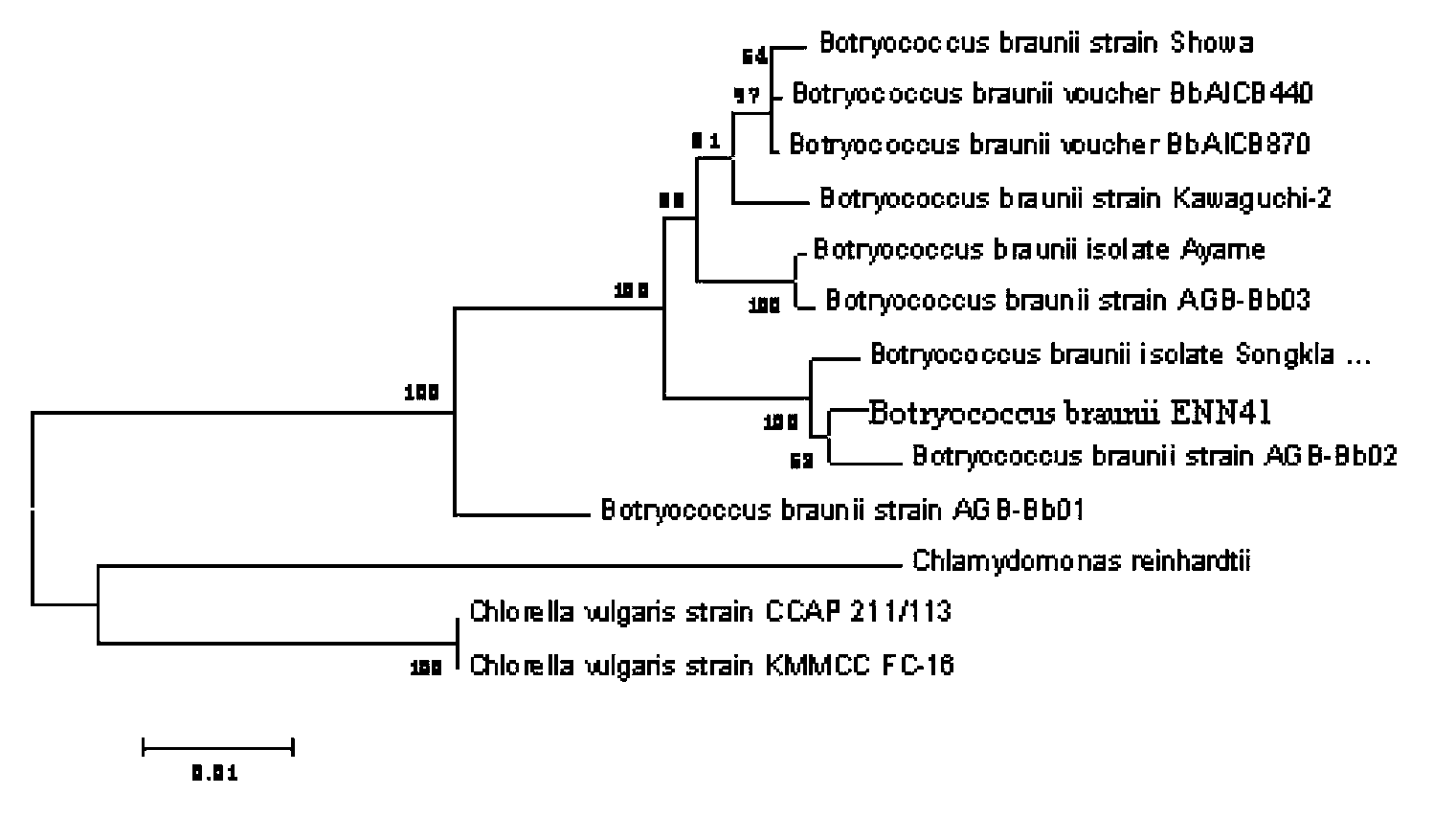Botryococcus braunii and application thereof
A technology of botrytis branii and algae strains, which is applied in the field of microbial engineering, can solve the problems of slow growth of botrytis, low total hydrocarbon content, and limited application, and achieve the effects of high hydrocarbon content, fast growth speed, and high biomass
- Summary
- Abstract
- Description
- Claims
- Application Information
AI Technical Summary
Problems solved by technology
Method used
Image
Examples
Embodiment 1
[0039] Example 1 Algae Strain Isolation, Purification, Screening
[0040] Method 1: Add 1 / 3 volume of BG11 medium (recipe in Table 1) to the pond water sample retrieved from Hainan area and culture it for about one month, draw 20-100 μL of water sample and drop it on the glass slide, use 40 times Or 100 times microscope observation, move the botrytis algae cells into the middle of the field of view, use a glass capillary tube with an inner diameter of 0.9-1.1 mm to burn through the outer flame of an alcohol lamp for 1-5 seconds, and then stretch it rapidly, and pull the capillary diameter to about 100 μm. Take algae cells directly under the microscope, inoculate them in 48-well culture plates filled with BG11 medium (recipe in Table 1), at 25°C, light intensity 50μmol / m 2 ·Cultivate for about 3 weeks under the condition of s, observe under the microscope, select the wells with only a single algae strain, and spread or streak the plate to obtain a single algae strain.
[0041]...
Embodiment 2
[0047] Example 2 Classification and Identification
[0048] (1) Shape identification
[0049] Observed under the microscope, the shape of ENN41 algal cells is oval or wedge-shaped, and they are clustered in clusters; cell size: 6 μm to 8 μm in length, 5 μm to 7 μm in width, and the aggregate size is more than 50 μm; the color of the cells is black green or yellowish brown; the cell package Enclosed in irregularly branched or leafed, translucent gelatinous colonies; cell division often forms two spore-like spores, and colonies often break into smaller colonies. The strain was initially identified as Botryococcus braunii.
[0050] Microscopic examination pictures such as figure 2 shown.
[0051] (2) Molecular identification:
[0052] 18S sequence amplification uses eukaryotic 18S amplification universal primers (primers were synthesized by Shanghai Sangon Bioengineering Co., Ltd.).
[0053] Primer 15'CCTGGTTGATCCTGCCAG 3'
[0054] Primer 25'TTGATCCTTCTGCAGGTTCA 3'
[005...
Embodiment 3
[0072] The growth situation of embodiment 3 in 3cm column reactor
[0073] Inoculate the ENN41 algae strain in the logarithmic growth phase in the prepared BG11 medium (see Table 1 for the formula) to make the cell density reach OD 750 is 0.3. The reactor used for the cultivation was a column reactor with an inner diameter of 30 mm and a length of 600 mm. The light intensity is gradually increased according to the cell state and density, and the light intensity is controlled at 50-500 μmol / m during the culture process 2 ·s. 24 hours of light, during the culture period, the pH value of the culture medium is adjusted between 7 and 9 by feeding a mixed gas of 1.5 to 2% carbon dioxide and air into the culture solution. The temperature is controlled within the range of 20-35°C. During the cultivation process, samples were taken regularly to determine the dry weight, and the results were shown in Figure 5 . The ENN41 algae strain was cultured in the general-purpose BG11 mediu...
PUM
| Property | Measurement | Unit |
|---|---|---|
| The inside diameter of | aaaaa | aaaaa |
| Dry weight | aaaaa | aaaaa |
Abstract
Description
Claims
Application Information
 Login to View More
Login to View More - R&D Engineer
- R&D Manager
- IP Professional
- Industry Leading Data Capabilities
- Powerful AI technology
- Patent DNA Extraction
Browse by: Latest US Patents, China's latest patents, Technical Efficacy Thesaurus, Application Domain, Technology Topic, Popular Technical Reports.
© 2024 PatSnap. All rights reserved.Legal|Privacy policy|Modern Slavery Act Transparency Statement|Sitemap|About US| Contact US: help@patsnap.com










